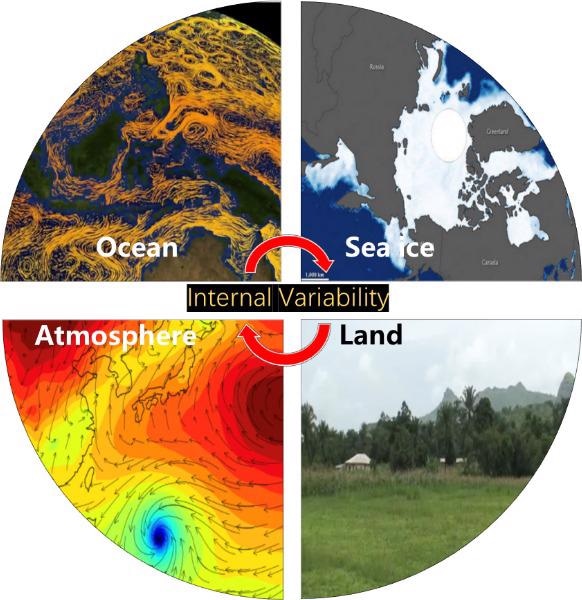According to the IPCC AR6 report, right from the beginning of the industrial revolution era, Arctic Sea ice melting, global warming, and growing sea-level increase are attributed to human activity.
 Internal variability generated from internal processes in the climate or Earth system and how it can impact climate change. Image Credit: Pengfei Lin.
Internal variability generated from internal processes in the climate or Earth system and how it can impact climate change. Image Credit: Pengfei Lin.
The response of climate change to external forcings (such as a human activity) is non-linear and is impacted by internal variabilities (IVs) generated primarily from internal processes in the climate or Earth system.
In recent times, researchers have discovered that IVs, such as the Pacific Decadal Oscillation or Inter-decadal Pacific Oscillation, and the Atlantic Multi-decadal Oscillation, will highly affect the Walker Circulation and Global Monsoon across the next 30 years.
Furthermore, IVs are known to be significant sources of uncertainties in comprehending historical climate change, particularly at the regional scale. IVs are beneficial for learning about mitigation strategies, climate change, and providing guidance for policymakers.
Climate system models help IV research by providing simulations, particularly when using single-model initial-condition large ensemble simulations, which are a collection of simulations tied to a single climate model under a specific radiative forcing scenario.
The huge ensemble simulations employ perturbations, or deviations from normal input, to the initial conditions of every member to make diverging climate and weather trajectories. The ensemble sizes of huge ensemble simulations are subject to computational and resource limits that are similar to those utilized in early studies.
Lately, numerous modeling center research groups have performed single-model initial-condition huge ensemble simulations that are currently possible with computer abilities that are on the constant increase.
Applying huge ensemble simulations to learn about climate change has been a hotspot in climate research. For example, the National Center for Atmospheric Research (NCAR) liberated a large ensemble simulation in 2015 that has been cited over one thousand times.
So far, the ensemble sizes have featured no greater than 100 members and, even now, few ensemble simulations have around 100 ensemble sizes.
To analyze the effect of IVs on future global monsoon projections, the LASG ocean model team group from the Institute of Atmospheric Physics (IAP), Chinese Academy of Sciences (CAS) generated a super-large ensemble simulation along with 110 members from their FGOALS-g3 climate system model.
The study was reported in the journal Advances in Atmospheric Sciences.
The Super-large Ensemble experiments of CAS FGOALS-g3 are the first set of large ensemble simulations from a global climate system model named FGOALS-g3 developed by IAP, CAS. The large ensemble simulation has the largest sample numbers in the world.
Bowen Zhao, Study Lead Author, Institute of Atmospheric Physics, Chinese Academy of Sciences
Every member consists of a simulation for the climate system model, such as the ocean, sea ice, atmosphere, and land components. Scientists completely sampled the various phases of decadal ocean variability as the initial model declares under the standard CMIP6 historical forcing conditions.
Also, they included the Shared Socioeconomic Pathway scenario (SSP5-8.5), indicating extremely high greenhouse gas emissions. Such simulations span a period between 1850 to 2099.
Our assessment also shows that these ensembles are capable of accurately capturing surface air temperature response (Figure 2) and land precipitation, including extreme climate events as well as external forcings, and we can quantify the internal variabilities.
Bowen Zhao, Study Lead Author, Institute of Atmospheric Physics, Chinese Academy of Sciences
Zhao added, “Having more than 100 simulations and their realizations helps us study rare events and improve our understanding of the impact of internal variability on forced climate changes.”
This study was financially supported by the National Key Program for Developing Basic Sciences (Grant No. 2020YFA0608902), and the National Natural Science Foundation of China (Grant Nos. 41976026 and 41931183).
Journal Reference:
Lin, P., et al. (2022) The Super-large Ensemble Experiments of CAS FGOALS-g3. Advances in Atmospheric Sciences. doi.org/10.1007/s00376-022-1439-1